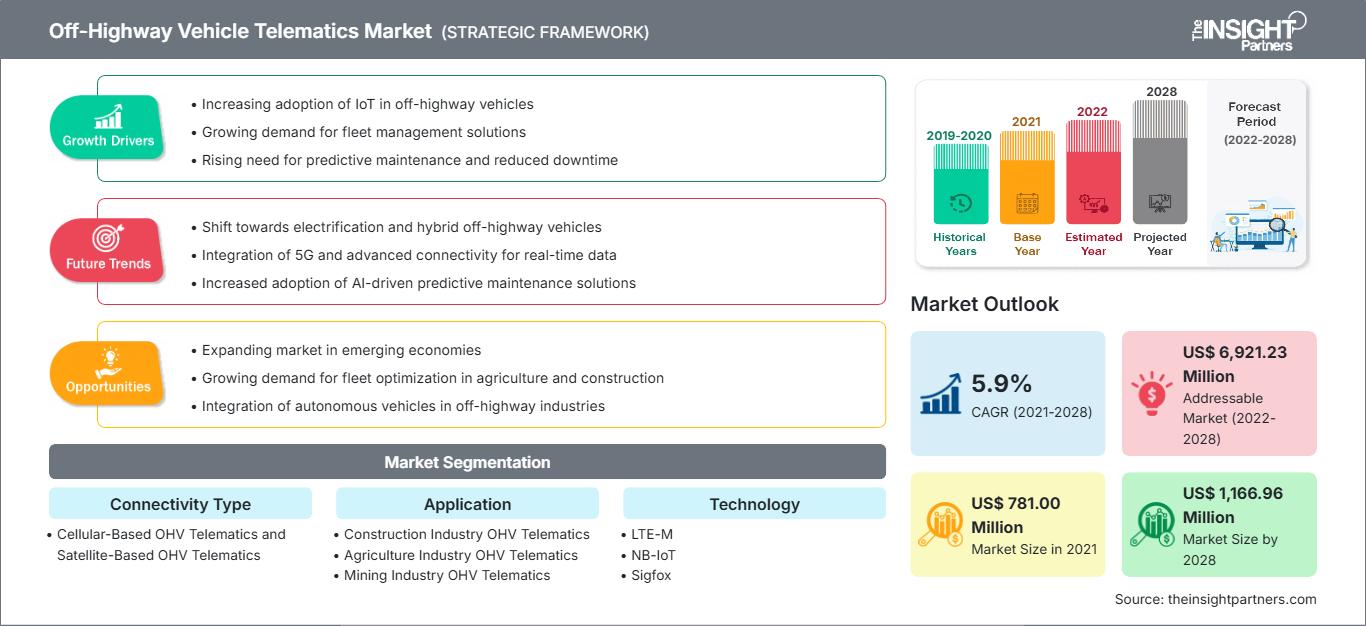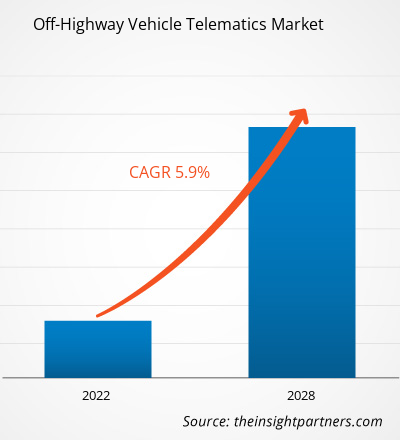2021 年非公路用车远程信息处理市场价值 7.81 亿美元,预计到 2028 年将达到 11.6696 亿美元;预计在 2021 年至 2028 年的预测期内,复合年增长率将达到 5.9%。
随着技术的进步,远程信息处理业务发展迅速。为了保持竞争优势,必须研究一些即将出现的新趋势:
- 快速互联网络:升级到 4G 和 5G 网络可在带宽、更快的数据上传和反馈下载方面提供全新的体验,从而产生更多实时数据集,实时保障驾驶员安全,维护车队安全并提高车队效率。
- 云支持:传感器连接到车辆的不同子系统。这些系统不断交换大量数据。用于胎压监测、视频捕捉和温度监测的传感器只是其中几个例子。云技术的进步使得存储、处理和成功使用海量数据成为可能。
- 小型企业的采用:远程信息处理已不仅仅是服务提供商和小型车队所有者的一种趋势。许多初创公司提供低成本但有效的远程信息处理解决方案,这些解决方案可以在当地市场上为小型车队所有者找到。
- 直接数据访问和直观的仪表盘:用户可以直接访问数据进行决策。个人驾驶员、调度经理、中央车队代理机构或当地办事处以及特许经营商都可以从这些数据中受益。所有利益相关者都将获得基于角色的个性化仪表盘,但访问权限受限,以便根据其特定的服务需求、交付或到达时间、处理限制和其他因素做出明智的实时决策。这也有助于车队管理企业维护基于行为的驾驶员记分卡,并具有法律意义。许多公司还与航运和运输行业交换数据,以改进码头调度。这有助于有效规划,使驾驶员更加快乐、高效。
因此,非公路车辆远程信息处理技术的不断进步将推动非公路车辆远程信息处理市场的增长。
自定义此报告以满足您的要求
您将免费获得任何报告的定制,包括本报告的部分内容,或国家级分析、Excel 数据包,以及为初创企业和大学提供超值优惠和折扣
非公路车辆远程信息处理市场: 战略洞察

-
获取本报告的主要市场趋势。这个免费样本将包括数据分析,从市场趋势到估计和预测。
建筑行业快速的数字化转型推动了新技术的应用,这为非公路车辆远程信息处理市场带来了新的前景。建筑设备远程信息处理可帮助公司追踪其设备的位置和性能,监控资产利用率,并验证资产是否得到有效利用。如果设备未得到充分利用,则可以将其转移到其他需要的位置。建筑设备远程信息处理技术就是这样提高整体效率的,从而对非公路车辆远程信息处理市场产生积极影响。
此外,私营和公共部门建筑活动的增加可能会促进市场增长。印度、菲律宾、阿联酋、沙特阿拉伯、埃及、尼日利亚和美国等国家正在实施或计划实施多个基础设施相关项目。例如,印度政府在2014-2015年联邦预算中,为本财年拨款11.2亿美元,作为“百座智慧城市”计划的一部分。此外,政府计划在未来20年内投资6500亿美元用于全国范围内的各种城市和基础设施项目,这反过来将支持非公路用车远程信息处理市场的增长。中东地区的各种基础设施项目正在进行中,包括吉达经济城(沙特阿拉伯)、马斯达尔城(阿联酋)和迪拜乐园(阿联酋)。基础设施项目的快速增长可能会增加对建筑设备的需求。
新冠疫情对北美非公路用车远程信息处理市场的影响
得益于政府鼓励创新和加强基础设施能力的优惠政策,北美在新技术的开发和应用方面处于领先地位。因此,任何对工业部门增长的不利影响都会阻碍该地区的经济增长。目前,美国是受新冠疫情影响全球最严重的国家。非公路用车远程信息处理市场对汽车公司和汽车零部件制造商等制造业参与者的依赖,最近因 COVID-19 疫情爆发导致制造业停工而凸显出来。甚至在 COVID-19 疫情爆发之前,汽车行业就面临着电动汽车、无人驾驶汽车、自动化工厂和拼车等挑战。由于严格的旅行限制、国际制造业的关闭、汽车销量下降以及大规模裁员,汽车行业正遭受重大挫折。一旦行业恢复正常运营,对非公路用车远程信息处理的整体需求可能会增加。由于汽车需求的增长、政府的优惠政策以及北美国家对先进技术的投资不断增加,北美对非公路用车远程信息处理的需求很大。
非公路车辆远程信息处理市场洞察
物联网日益融合
微机电系统、互联网和无线技术共同构成了物联网 (IoT)。车队所有者可以利用物联网远程监控车速、胎压、燃油消耗和驾驶员行为,从而进一步提高车辆和驾驶员的效率。远程信息处理系统开发人员可以利用这项技术,针对运营成本高昂的采矿、农业和建筑行业的特定需求,创建量身定制的远程信息处理解决方案。服务提供商和车队运营商可以通过结合物联网和车队管理技术来采用预测分析。这为实现主动管理并在多个关键运营领域获得竞争优势提供了条件。空调等服务导向产品中的物联网传感器只能在需要时而不是定期通知服务请求。基于状态的监控可以降低服务成本,同时提高准确性和客户服务。燃油是任何车队最大的开支之一。如果将物联网传感器集成到远程信息处理系统中,车队管理人员可以近乎实时地了解车辆的燃油使用情况和支出。这使管理人员能够了解哪些人需要接受有效驾驶行为的培训,并追踪违规的运营支出和驾驶模式,例如怠速怠速,因为这些模式会浪费汽油。此外,所有车队都高度重视安全。随着超速、急刹车和鲁莽驾驶事件的增多,车队管理人员可以通过驾驶员指导和安全教育来解决不良驾驶行为。因此,物联网的日益融合可以开辟新的商业可能性。
基于连接类型的市场洞察
根据连接类型,非公路车辆远程信息处理市场细分为基于蜂窝的OHV远程信息处理和基于卫星的OHV远程信息处理。 2020年,基于蜂窝网络的OHV远程信息处理领域以77.6%的市场份额领跑非公路车辆远程信息处理市场。
基于应用的市场洞察
根据应用,非公路车辆远程信息处理市场可细分为建筑行业OHV远程信息处理、农业行业OHV远程信息处理、采矿行业OHV远程信息处理及其他。2020年,建筑行业OHV远程信息处理领域以64.3%的市场份额领跑非公路车辆远程信息处理市场。
非公路车辆远程信息处理市场
The Insight Partners 的分析师已详尽阐述了预测期内影响非公路车辆远程信息处理市场的区域趋势和因素。本节还讨论了北美、欧洲、亚太地区、中东和非洲以及南美和中美洲的非公路车辆远程信息处理市场的各个细分市场和地域分布。
非公路车辆远程信息处理市场报告范围
| 报告属性 | 细节 |
|---|---|
| 市场规模 2021 | US$ 781.00 Million |
| 市场规模 2028 | US$ 1,166.96 Million |
| 全球复合年增长率 (2021 - 2028) | 5.9% |
| 历史数据 | 2019-2020 |
| 预测期 | 2022-2028 |
| 涵盖的领域 |
By 连接类型
|
| 覆盖地区和国家 |
北美
|
| 市场领导者和主要公司简介 |
|
非公路车辆远程信息处理市场参与者密度:了解其对业务动态的影响
非公路车辆远程信息处理市场正在快速增长,这得益于终端用户需求的不断增长,而这些需求的驱动因素包括消费者偏好的不断变化、技术进步以及对产品优势的认知度不断提高。随着需求的增长,企业正在扩展其产品线,不断创新以满足消费者需求,并抓住新兴趋势,从而进一步推动市场增长。

- 获取 非公路车辆远程信息处理市场 主要参与者概述
基于技术的市场洞察
根据技术,非公路车辆远程信息处理市场可细分为 LTE-M、NB-IoT、Sigfox 等。2020 年,LTE-M 以 82.3% 的市场份额领跑非公路车辆远程信息处理市场。
非公路车辆远程信息处理市场的参与者采用并购和市场举措等策略来保持其市场地位。以下列出了一些主要参与者的进展:
- 2022年1月,Stoneridge 和 Valens 半导体公司建立合作伙伴关系,共同开发通过先进互联互通和视觉解决方案实现的牵引车-拖车安全系统,这将对非公路远程信息处理市场产生积极影响。
- 2020年8月,HY-TTC 500 控制器系列获得道路使用认证。HY-TTC 500 由高端安全控制单元组成,旨在构建安全、集中式的电子架构。 TTControl 旗下产品 HY-TTC 500 控制器获得 ISO 26262 道路使用认证。
公司简介
- Omnitracs, LLC
- ORBCOMM
- Stoneridge, Inc.
- Teletrac Navman
- TomTom International BV
- Trackunit A/S
- Wacker Neuson
- Zonar Systems Inc.
- TTCONTROL GMBH
- ACTIA Group
- 历史分析(2 年)、基准年、预测(7 年)及复合年增长率
- PEST和SWOT分析
- 市场规模、价值/数量 - 全球、区域、国家
- 行业和竞争格局
- Excel 数据集
近期报告
相关报告
客户评价
购买理由
- 明智的决策
- 了解市场动态
- 竞争分析
- 客户洞察
- 市场预测
- 风险规避
- 战略规划
- 投资论证
- 识别新兴市场
- 优化营销策略
- 提升运营效率
- 顺应监管趋势






















 获取免费样品 - 非公路车辆远程信息处理市场
获取免费样品 - 非公路车辆远程信息处理市场